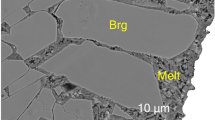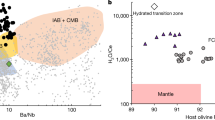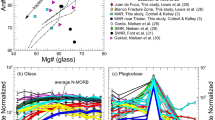Abstract
The transition from the Archaean to the Proterozoic eon ended a period of great instability at the Earth’s surface. The origin of this transition could be a change in the dynamic regime of the Earth’s interior. Here we use laboratory experiments to investigate the solidus of samples representative of the Archaean upper mantle. Our two complementary in situ measurements of the melting curve reveal a solidus that is 200–250 K lower than previously reported at depths higher than about 100 km. Such a lower solidus temperature makes partial melting today easier than previously thought, particularly in the presence of volatiles (H2O and CO2). A lower solidus could also account for the early high production of melts such as komatiites. For an Archaean mantle that was 200–300 K hotter than today, significant melting is expected at depths from 100–150 km to more than 400 km. Thus, a persistent layer of melt may have existed in the Archaean upper mantle. This shell of molten material may have progressively disappeared because of secular cooling of the mantle. Crystallization would have increased the upper mantle viscosity and could have enhanced mechanical coupling between the lithosphere and the asthenosphere. Such a change might explain the transition from surface dynamics dominated by a stagnant lid on the early Earth to modern-like plate tectonics with deep slab subduction.
This is a preview of subscription content, access via your institution
Access options
Access Nature and 54 other Nature Portfolio journals
Get Nature+, our best-value online-access subscription
$29.99 / 30 days
cancel any time
Subscribe to this journal
Receive 12 print issues and online access
$259.00 per year
only $21.58 per issue
Buy this article
- Purchase on Springer Link
- Instant access to full article PDF
Prices may be subject to local taxes which are calculated during checkout




Similar content being viewed by others
References
Solomatov, V. S. in Treatise on Geophysics Vol. 9 (ed. G. Schubert) 81–104 (Elsevier, Amsterdam, 2015).
Romanowicz, B. A global tomographic model of the shear attenuation in the upper mantle. J. Geophys. Res. Solid Earth 100, 12375–12394 (1995).
Tauzin, B., Debayle, E. & Wittlinger, G. Seismic evidence for a global low-velocity layer within the Earth’s upper mantle. Nat. Geosci. 3, 718–721 (2010).
Lay, T., Garnero, E. J. & Williams, Q. Partial melting in a thermo-chemical boundary layer at the base of the mantle. Phys. Earth Planet. Inter. 146, 441–467 (2004).
Ferot, A. & Bolfan-Casanova, N. Water storage capacity in olivine and pyroxene to 14 GPa: implications for the water content of the Earth’s upper mantle and nature of seismic discontinuities. Earth Planet. Sci. Lett. 349, 218–230 (2012).
Aubaud, C., Hauri, E. H. & Hirschmann, M. M. Hydrogen partition coefficients between nominally anhydrous minerals and basaltic melts. Geophys. Res. Lett. 31, L20611 (2004).
Herzberg, C., Raterron, P. & Zhang, J. New experimental observations on the anhydrous solidus for peridotite KLB-1. Geochem. Geophys. Geosyst. 1, 1051 (2000).
Iwamori, H., McKenzie, D. & Takahashi, E. Melt generation by isentropic mantle upwelling. Earth Planet. Sci. Lett. 134, 253–266 (1995).
Trønnes, R. G. & Frost, D. J. Peridotite melting and mineral–melt partitioning of major and minor elements at 22–24.5 GPa. Earth Planet. Sci. Lett. 197, 117–131 (2002).
Walter, M. J. Melting of garnet peridotite and the origin of komatiite and depleted lithosphere. J. Petrol. 39, 29–60 (1998).
Agee, C. B., Li, J., Shannon, M. C. & Circone, S. Pressure–temperature phase-diagram for the Allende meteorite. J. Geophys. Res. Solid Earth 100, 17725–17740 (1995).
Litasov, K. & Ohtani, E. Phase relations and melt compositions in CMAS–pyrolite–H2O system up to 25 GPa. Phys. Earth Planet. Inter. 134, 105–127 (2002).
Katsura, T., Yoneda, A., Yamazaki, D., Yoshino, T. & Ito, E. Adiabatic temperature profile in the mantle. Phys. Earth Planet. Inter. 183, 212–218 (2010).
Laporte, D., Toplis, M. J., Seyler, M. & Devidal, J. L. A new experimental technique for extracting liquids from peridotite at very low degrees of melting: application to partial melting of depleted peridotite. Contrib. Mineral. Petrol. 146, 463–484 (2004).
Sifre, D. et al. Electrical conductivity during incipient melting in the oceanic low-velocity zone. Nature 509, 81–85 (2014).
Sato, H. & Ida, Y. Low frequency electrical impedance of partially molten gabbro: the effect of melt geometry on electrical properties. Tectonophysics 107, 105–134 (1984).
Partzsch, G. M., Schilling, F. R. & Arndt, J. The influence of partial melting on the electrical behavior of crustal rocks: laboratory examinations, model calculations and geological interpretations. Tectonophysics 317, 189–203 (2000).
Maumus, J., Bagdassarov, N. & Schmeling, H. Electrical conductivity and partial melting of mafic rocks under pressure. Geochim. Cosmochim. Acta 69, 4703–4718 (2005).
Andrault, D. et al. Melting of subducted basalt at the core–mantle boundary. Science 344, 892–895 (2014).
Davis, F. A., Hirschmann, M. M. & Humayun, M. The composition of the incipient partial melt of garnet peridotite at 3 GPa and the origin of OIB. Earth Planet. Sci. Lett. 308, 380–390 (2011).
Yoshino, T., Laumonier, M., McIsaac, E. & Katsura, T. Electrical conductivity of basaltic and carbonatite melt-bearing peridotites at high pressures: implications for melt distribution and melt fraction in the upper mantle. Earth Planet. Sci. Lett. 295, 593–602 (2010).
Chantel, J. et al. Experimental evidence supports mantle partial melting in the asthenosphere. Sci. Adv. 2, e1600246 (2016).
Hirschmann, M. M. Mantle solidus: experimental constraints and the effects of peridotite composition. Geochem. Geophys. Geosyst. 1, C000070 (2000).
Simon, F. & Glatzel, G. Fusion–pressure curve. Z. Anorg. Allg. Chem. 178, 309–316 (1929).
Zhang, J. & Herzberg, C. Melting experiments on anhydrous peridotite KLB-1 from 5.0 to 22.5 GPa. J. Geophys. Res. 99, 17729–17742 (1994).
Hirose, K. & Kushiro, I. Partial melting of dry peridotite at high-pressures—determination of compositions of melts segregated from peridotite using aggregates of diamonds. Earth Planet. Sci. Lett. 114, 477–489 (1993).
Béjina, F., Jaoul, O. & Liebermann, R. C. Diffusion in minerals at high pressure: a review. Phys. Earth Planet. Inter. 139, 3–20 (2003).
Hirschmann, M. M., Asimow, P. D., Ghiorso, M. S. & Stolper, E. M. Calculation of peridotite partial melting from thermodynamic models of minerals and melts. III. Controls on isobaric melt production and the effect of water on melt production. J. Petrol. 40, 831–851 (1999).
Dalton, C. A., Langmuir, C. H. & Gale, A. Geophysical and geochemical evidence for deep temperature variations beneath mid-ocean ridges. Science 344, 80–83 (2014).
Litasov, K. D., Shatskiy, A. & Ohtani, E. Melting and subsolidus phase relations in peridotite and eclogite systems with reduced C–O–H fluid at 3–16 GPa. Earth Planet. Sci. Lett. 391, 87–99 (2014).
Herzberg, C., Condie, K. & Korenaga, J. Thermal history of the Earth and its petrological expression. Earth Planet. Sci. Lett. 292, 79–88 (2010).
Kamber, B. S. The evolving nature of terrestrial crust from the Hadean, through the Archaean, into the Proterozoic. Precambrian Res. 258, 48–82 (2015).
Arndt, J., Barnes, S. J. & Lesher, C. M. Komatiite (Cambridge Univ. Press, Cambridge, 2008).
Korenaga, J. Initiation and evolution of plate tectonics on Earth: theories and observations. Annu. Rev. Earth Planet. Sci. 41, 117–151 (2013).
van Hunen, J. & Moyen, J.-F. in Annual Review of Earth and Planetary Sciences Vol. 40 (ed. R. Jeanloz) 195–219 (Annual Reviews, Palo Alto, CA, 2012).
Moore, W. B. & Webb, A. A. G. Heat-pipe Earth. Nature 501, 501–505 (2013).
Michaut, C. & Jaupart, C. Secular cooling and thermal structure of continental lithosphere. Earth Planet. Sci. Lett. 257, 83–96 (2007).
Monteux, J., Andrault, D. & Samuel, H. On the cooling of a deep terrestrial magma ocean. Earth Planet. Sci. Lett. 448, 140–149 (2016).
Matsukage, K. N., Jing, Z. C. & Karato, S. Density of hydrous silicate melt at the conditions of Earth’s deep upper mantle. Nature 438, 488–491 (2005).
Sakamaki, T., Suzuki, A. & Ohtani, E. Stability of hydrous melt at the base of the Earth’s upper mantle. Nature 439, 192–194 (2006).
Sizova, E., Gerya, T., Brown, M. & Perchuk, L. L. Subduction styles in the Precambrian: insight from numerical experiments. Lithos 116, 209–229 (2010).
Foley, B. J., Bercovici, D. & Elkins-Tanton, L. T. Initiation of plate tectonics from post-magma ocean thermochemical convection. J. Geophys. Res. Solid Earth 119, 8538–8561 (2014).
Doglioni, C., Ismail-Zadeh, A., Panza, G. & Riguzzi, F. Lithosphere–asthenosphere viscosity contrast and decoupling. Phys. Earth Planet. Inter. 189, 1–8 (2011).
Jin, Z. M., Green, H. W. & Zhou, Y. Melt topology in partially molten mantle peridotite during ductile deformation. Nature 372, 164–167 (1994).
Corgne, A., Liebske, C., Wood, B. J., Rubie, D. C. & Frost, D. J. Silicate perovskite-melt partitioning of trace elements and geochemical signature of a deep perovskitic reservoir. Geochim. Cosmochim. Acta 69, 485–496 (2005).
Hennet, L. et al. Aerodynamic levitation and laser heating: applications at synchrotron and neutron sources. Eur. Phys. J. Spec. Top. 196, 151–165 (2011).
Tenner, T. J. & Hirschmann, M. M. & Humayun, M. The effect of H2O on partial melting of garnet peridotite at 3.5 GPa.Geochem. Geophys. Geosyst. 13, Q03016 (2012).
Boujibar, A. et al. Metal–silicate partitioning of sulphur, new experimental and thermodynamic constraints on planetary accretion. Earth Planet. Sci. Lett. 391, 42–54 (2014).
Hernlund, J., Leinenweber, K., Locke, D. & Tyburczy, J. A. A numerical model for steady-state temperature distributions in solid-medium high-pressure cell assemblies. Am. Miner. 91, 295–305 (2006).
Yoshino, T. Laboratory electrical conductivity measurement of mantle minerals. Surv. Geophys. 31, 163–206 (2010).
Manthilake, M. et al. Electrical conductivity of wadsleyite as a function of temperature and water content. Phys. Earth Planet. Inter 174, 10–18 (2009).
Wang, Y. B. et al. A new technique for angle-dispersive powder diffraction using an energy-dispersive setup and synchrotron radiation. J. Appl. Crystallogr. 37, 947–956 (2004).
Yamazaki, D., Kato, T., Ohtani, E. & Toriumi, M. Grain growth rates of MgSiO3 perovskite and periclase under lower mantle conditions. Science 274, 2052–2054 (1996).
Acknowledgements
We thank A. Bouhifd, N. Cayzer, M. Guitreau, T. Kawamoto, T. Komabayashi, D. Laporte, M. Laumonier, H. Martin, S. Parman, B. Reynard and F. Schiavi for help and fruitful discussions. This work was supported by the French National Research Agency (ANR) contract ‘OxyDeep’. This research was financed by the French Government Laboratory of Excellence initiative no. ANR-10-LABX-0006, the Région Auvergne and the European Regional Development Fund. This is Laboratory of Excellence ClerVolc contribution number 279.
Author information
Authors and Affiliations
Contributions
L.H. and G.P. synthesized the glass starting material. G.P. and G.M. performed the EC measurements. G.P., D.A., G.M., N.B.C., D.N., N.G. and A.K. performed the X-ray diffraction measurements, which were subsequently treated by D.A. G.P. and N.B.C. determined the water content in samples using infrared spectroscopy. D.A. wrote the manuscript with help from G.P., G.M. and J.M. All of the authors discussed and commented on various versions of the manuscript.
Corresponding author
Additional information
Publisher’s note: Springer Nature remains neutral with regard to jurisdictional claims in published maps and institutional affiliations.
Supplementary information
Supplementary Information
Supplementary Figures and Tables.
Rights and permissions
About this article
Cite this article
Andrault, D., Pesce, G., Manthilake, G. et al. Deep and persistent melt layer in the Archaean mantle. Nature Geosci 11, 139–143 (2018). https://doi.org/10.1038/s41561-017-0053-9
Received:
Accepted:
Published:
Issue Date:
DOI: https://doi.org/10.1038/s41561-017-0053-9
This article is cited by
-
A cool runaway greenhouse without surface magma ocean
Nature (2023)
-
Structure, Materials and Processes in the Earth’s Core and Mantle
Surveys in Geophysics (2022)
-
Intraplate volcanism originating from upwelling hydrous mantle transition zone
Nature (2020)
-
Breaking Earth’s shell into a global plate network
Nature Communications (2020)
-
Deep hydrous mantle reservoir provides evidence for crustal recycling before 3.3 billion years ago
Nature (2019)



